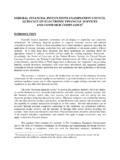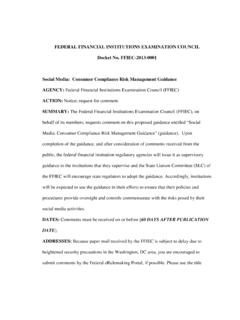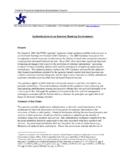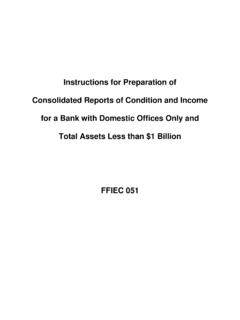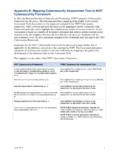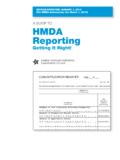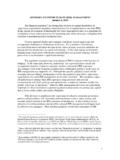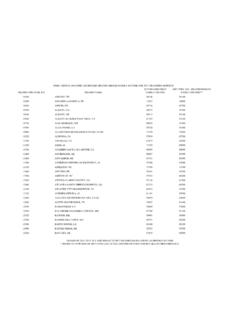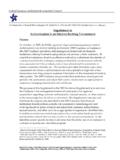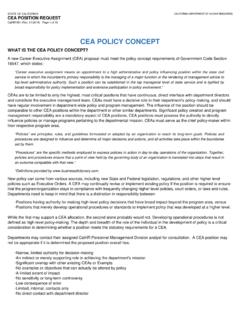Transcription of Customer Due Diligence - Overview - ffiec.gov
1 Customer Due Diligence Overview ffiec BSA/AML Examination Manual 1 05/05/2018 Customer Due Diligence Overview Objective. Assess the bank s compliance with the regulatory requirements for Customer due Diligence (CDD). The cornerstone of a strong BSA/AML compliance program is the adoption and implementation of risk-based CDD policies, procedures, and processes for all customers, particularly those that present a higher risk for money laundering and terrorist financing. The objective of CDD is to enable the bank to understand the nature and purpose of Customer relationships, which may include understanding the types of transactions in which a Customer is likely to engage.
2 These processes assist the bank in determining when transactions are potentially suspicious. Effective CDD policies, procedures, and processes provide the critical framework that enables the bank to comply with regulatory requirements including monitoring for and reporting of suspicious activity. An illustration of this concept is provided in Appendix K ( Customer Risk versus Due Diligence and Suspicious Activity Monitoring ). CDD policies, procedures, and processes are critical to the bank because they can aid in: Detecting and reporting unusual or suspicious activity that potentially exposes the bank to financial loss, increased expenses, or other risks. Avoiding criminal exposure from persons who use or attempt to use the bank s products and services for illicit purposes.
3 Adhering to safe and sound banking practices. Customer Due Diligence FinCEN s final rule on CDD became effective July 11, 2016, with a compliance date of May 11, 2018. The rule codifies existing supervisory expectations and practices related to regulatory requirements and therefore, nothing in this final rule is intended to lower, reduce, or limit the due Diligence expectations of the federal functional regulators or in any way limit their existing regulatory In accordance with regulatory requirements, all banks must develop and implement appropriate risk-based procedures for conducting ongoing Customer due Diligence ,2 including, but not limited to: Obtaining and analyzing sufficient Customer information to understand the nature and purpose of Customer relationships for the purpose of developing a Customer risk profile.
4 And Conducting ongoing monitoring to identify and report suspicious transactions and, on a risk basis, to maintain and update Customer information, including information 1 Department of the Treasury, Financial Crimes Enforcement Network (2016), Customer Due Diligence Requirements for Financial Institutions, final rules (RIN 1506-AB25), Federal Register, vol. 81 (May 11), p. 29403. 2 See 31 CFR (b)(5) Customer Due Diligence Overview ffiec BSA/AML Examination Manual 2 05/05/2018 regarding the beneficial owner(s) of legal entity customers. Additional guidance can be found in the examination procedures Beneficial Ownership Requirements for Legal Entity Customers.
5 At a minimum, the bank must establish risk-based CDD procedures that: Enable the bank to understand the nature and purpose of the Customer relationship in order to develop a Customer risk profile. Enable the bank to conduct ongoing monitoring for the purpose of identifying and reporting suspicious transactions and, on a risk basis, to maintain and update Customer information, including information regarding the beneficial owner(s) of legal entity customers. In addition, the bank s risk-based CDD policies, procedures, and processes should: Be commensurate with the bank s BSA/AML risk profile, with increased focus on higher risk customers. Contain a clear statement of management s and staff s responsibilities, including procedures, authority, and responsibility for reviewing and approving changes to a Customer s risk profile, as applicable.
6 Provide standards for conducting and documenting analysis associated with the due Diligence process, including guidance for resolving issues when insufficient or inaccurate information is obtained. Customer Risk Profile The bank should have an understanding of the money laundering and terrorist financing risks of its customers, referred to in the rule as the Customer risk This concept is also commonly referred to as the Customer risk rating. Any Customer account may be used for illicit purposes, including money laundering or terrorist financing. Further, a spectrum of risks may be identifiable even within the same category of customers. The bank s program for determining Customer risk profiles should be sufficiently detailed to distinguish between significant variations in the money laundering and terrorist financing risks of its customers.
7 Improper identification and assessment of a Customer s risk can have a cascading effect, creating deficiencies in multiple areas of internal controls and resulting in an overall weakened BSA compliance program. The assessment of Customer risk factors is bank-specific, and a conclusion regarding the Customer risk profile should be based on a consideration of all pertinent Customer information, including ownership information generally. Similar to the bank s overall risk assessment, there are no required risk profile categories and the number and detail of these categorizations will vary based on the bank s size and complexity. Any one single indicator is not necessarily determinative of the existence of a lower or higher Customer risk.
8 3 See 31 CFR (b)(5)(i) Customer Due Diligence Overview ffiec BSA/AML Examination Manual 3 05/05/2018 Examiners should primarily focus on whether the bank has effective processes to develop Customer risk profiles as part of the overall CDD program. Examiners may review individual Customer risk decisions as a means to test the effectiveness of the process and CDD program. In those instances where the bank has an established and effective Customer risk decision-making process, and has followed existing policies, procedures, and processes, the bank should not be criticized for individual Customer risk decisions unless it impacts the effectiveness of the overall CDD program, or is accompanied by evidence of bad faith or other aggravating factors.
9 The bank should gather sufficient information about the Customer to form an understanding of the nature and purpose of Customer relationships at the time of account opening. This understanding may be based on assessments of individual customers or on categories of customers. An understanding based on categories of customers means that for certain lower-risk customers, the bank s understanding of the nature and purpose of a Customer relationship can be developed by inherent or self-evident information such as the type of Customer , the type of account opened, or the service or product offered. The factors the bank should consider when assessing a Customer risk profile are substantially similar to the risk categories considered when determining the bank s overall risk profile.
10 The bank should identify the specific risks of the Customer or category of customers, and then conduct an analysis of all pertinent information in order to develop the Customer s risk profile. In determining a Customer s risk profile, the bank should consider risk categories, such as the following, as they relate to the Customer relationship: Products and Services. Customers and Entities. Geographic Locations. As with the risk assessment, the bank may determine that some factors should be weighted more heavily than others. For example, certain products and services used by the Customer , the type of Customer s business, or the geographic location where the Customer does business, may pose a higher risk of money laundering or terrorist financing.
